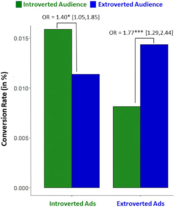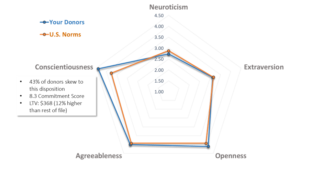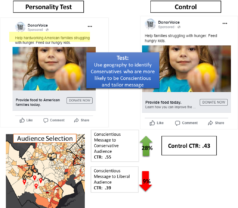A Missing Ingredient To Raising More Money – Donor Personality
Imagine running a digital ad or doing a list select for the mail and only being able to select a single attribute or audience parameter – e.g. age, geography, political affiliation.
My bet is most fundraisers would probably choose an attribute from Facebook or Google or a data co-op that indicated past charitable behavior.
Now, imagine you have to create two very different mailings or ads that will work differently for different audiences based on that single, known attribute that was selected.
Crazy, right? If the choice was ‘past donor’ in our hypothetical then the fundraiser is most probably grasping at straws. On what basis could she/he develop two concepts aimed at two different audiences with only one audience selected?
Considering most charities have at least several known attributes about their donors (e.g. past giving, gender, age, behavior) but still have only a single control or a single test idea it would seem that needing more attributes isn’t the barrier; it’s the understanding that goes with those different attributes.
Enter Personality. We’ve written about the Big Five Personality Primer here. One of the Big Five is Extroversion and it’s polar opposite, Introversion. This is probably the one Big Five trait that is familiar to every reader.
Let’s add another wrinkle to our thought experiment. Imagine instead of selling a charitable cause/brand you’re in charge of an ad to sell a beauty retailer (e.g. makeup). Again, with only one audience selection attribute. Easy, right? It has to be gender since the vast majority of beauty products are purchased by females.
Consider this live experiment instead. Researchers chose a single Facebook “like” and developed an ad aimed at what was known about this “like”. This wasn’t any random “like”, instead it was the top Like for those whose innate disposition or personality skews to Extraversion. The “like” for the curious was “Parties”. Makes sense. But the “like” behavior is a proxy for a rich, deep and innate understanding of the type of person that is typified by, among many other things, party “likes” on Facebook. The creative brief is tied to what we know about those higher in Extraversion; they are active, assertive, energetic, enthusiastic, outgoing and talkative etc.
Another, single “Like” was selected for Introverts (“Sanctuary”) and a matching brief; quiet, reserved, shy, silent, and withdrawn. The ads are below.

The results? Matching the ad to audience works and, importantly, when the mismatch occurs (Personality conflicts with ad), it suppresses behavior. This happens every single time you send a single control or test idea to an audience. This is the major, hidden or not so hidden flaw in fundraising that is holding us back as a sector, one-size-fits-all.

Here is how to do this for fundraising. We measured the Big Five profile for a sample of this charity’s donors and compared it to our database of US Norms. We see the donors skew towards Conscientiousness [Note: there is also opportunity with those higher in Openness and Agreeableness even though the file doesn’t stand out on those traits compared with population norms]

We know a tremendous amount about all five traits – where to find these people based on demographics and geography and proxy attribute data in the digital and non-digital realms. Just as importantly, or perhaps more so, we know how to message to these audiences. Targeting is about efficiency. Understanding how to get the attention of the audience and connect with their innate motivators (e.g. Personality, Identity) is about effectiveness.
We used political data as proxy for finding Conscientious people. We then made subtle but important changes to the control ad that increases the likelihood the ad is literally seen (we visually ignore that which doesn’t match who we are) and mentally processed in a positive way.
Conscientious people value hard work and consider themselves to be hard-working. They also tend to be orderly and orderly people tend to favor in-group loyalty. In this case the “in-group” is American as modifier on families.
We got lift where we expected – Conscientious ads aimed at and speaking to Conscientious people – and as further validation, suppressed response when we mismatched audience to message. This latter example is what happens with every single control or test ad you send out that is one-size-fits-all.

People are different in predictable ways on important, innate manners that directly influence behavior, just rarely based on the data that charities tend to make use of to segment – internally defined labels (active, lapsed, sustainer, one-time giver) or demographics.
Kevin


